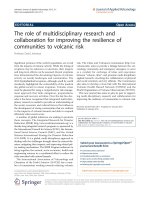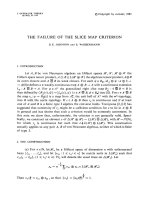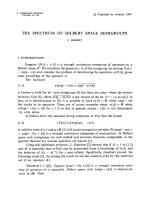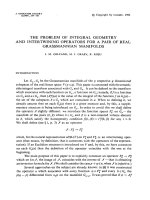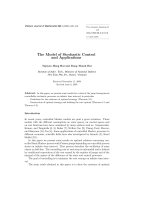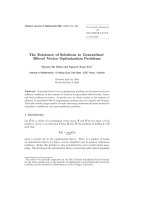Báo cáo toán học: "The Model of Stochastic Control and Applications" pdf
Bạn đang xem bản rút gọn của tài liệu. Xem và tải ngay bản đầy đủ của tài liệu tại đây (131.99 KB, 11 trang )
Vietnam Journal of Mathematics 33:4 (2005) 409–419
The Model of Stochastic Control
and Applications
Nguyen Hong Hai and Dang Thanh Hai
Institute of Infor. Tech., Ministry of National Defence
34A Tran Phu Str., Hanoi, Vietnam
Received No vember 11, 2004
Revised June 6, 2005
Abstract. In this paper, we present some results for a class of the jump homogeneous
controllable stochastic processes on infinite time interval, in particular
· Conditions for the existence of optimal strategy (Theorem 3.1).
· Construction of optimal strategy and defining the cost optimal (Theorem 4.1 and
Theorem 4.2).
Introduction
In recent years, controlled Markov models are paid a great attention. Those
models with the different assumptions on state spaces, on control spaces and
on cost functions have been considered by many authors such as: Arapostathis,
Kumar, and Tangiralla [6, 8]; Bokar [7]; Xi-Ren Cao [9]; Chang, Fard, Marcus,
and Shayman [11]; Liu [4]. Some applications of controlled Markov processes to
different economic, scientific fields have also investigated by Sennott [5]; Karel
Sladk´y [10]
In this paper we present some results on optimal solution concerning con-
trolled Semi-Markov process with Poisson jumps depending on controlled process
states on infinite time interval. That process describes the oscillation of some
object on half-line. The controlling cost at each step is unbounded and is defined
by conditional expectation of the cost caused by the number of jumps and of the
integral of the square of the difference of the state and control processes.
The goal of controlling is to minimize the cost evarage on infinite time inter-
val.
The main result obtained in this paper is to show the existence of optimal
410 Nguyen Hong Hai and Dang Thanh Hai
control, the method for establishing optimal strategy and for defining minimum
cost.
These results can be applied to queueing system and to renewal theory.
This paper is organized as follows:
Section 1: Defining control model.
Section 2: Formulas for the transition probabilities and for the cost.
Section 3: Existence of optimal strategy.
Section 4: Finding optimal strategy and optimal cost.
1. Defining Control Model
1.1. Constructure of the Model
Suppose there exist two sequences of independent random variables {η
n
|n =
1, 2, } and {ξ
n
|n =1, 2, } defined on probability spase (Ω, A,P). Those
sequences are independent and satisfy the following conditions:
• ξ
n
> 0; n =1, 2, (modP )
•
E|ξ
n
|
p
< +∞,n=1, 2, , p ≥ 3
E|η
n
|
q
< +∞,n=1, 2, , q ≥ 2.
Let us consider a stochastic control system with state process {x
n
|n =
1, 2, } and with control process {u
n
= u(μ
n
)|n =1, 2, } described as fol-
lows:
For an initial state of elementary process x
1
= x(x ∈ R), at the first step, a
sequence of controlling variables
u
1
= u(μ
1
):=
ξ
1,j
| j =1, 2, , ν
μ
1
(ξ
1
)+1
is defined, where ξ
1,j
are the exponentially distributed independent random vari-
ables with the parameter μ
1
(μ
1
> 0), and ν
μ
1
(ξ
1
) is the random variable defined
as follows:
ν
µ
1
(ξ
1
)
j=1
ξ
1,j
ξ
1
<
ν
µ
1
(ξ
1
)+1
j=1
ξ
1,j
a.s.
The values μ
1
are called controlling parameter at the first step.
By induction, suppose that at the n-th step (n ≥ 1) if controlled process is
at the state x
n
and controlling variables u
n
= u(μ
n
) selected corresponding to
the parameter μ
n
(μ
n
> 0), then the state x
n+1
will be defined by the following
formula
x
n+1
= η
n
+ x
n
− ν
μ
n
(ξ
n
),
whereas the controlling variable is defined by
u
n+1
= u(μ
n+1
):=
ξ
n+1,j
|j =1, 2, ν
μ
n+1
(ξ
n+1
)+1
,
where ξ
n+1,j
is the sequence of the exponentially distributed independent ran-
dom variables with the parameter μ
n+1
(μ
n+1
> 0), and ν
μ
n+1
(ξ
n+1
) is random
variable defined by
The Model of Stochastic Control and Applications 411
ν
µ
n+1
(ξ
n+1
)
j=1
ξ
n+1,j
ξ
n+1
<
ν
µ
n+1
(ξ
n+1
)+1
j=1
ξ
n+1,j
a.s.
μ
n+1
is called controlling parameter at the (n +1)-th step.
U =
u
n
= u(μ
n
)|n =1, 2,
is called a controlling strategy.
1.2. Definition of the Cost
If at the n-th step, the state of elementary process is x and we selected a control
with the parameter μ(μ>0) then we define the cost at this step by formula
r
n
(x, μ)=E
a
ν
μ
n
(ξ
n
)+1
+
ξ
n
0
η
n
+ x
n
− ν
μ
n
(t)
2
dt
x
n
=x,μ
n
=μ
,
where a is a positive constant, ν
μ
(t) is the number of independent random vari-
ables, possessing the exponential distribution with parameter μ(μ>0) and such
that their sum is less than or equal to t(t>0)(ν
μ
(t) have Poisson’s distribution
with parameter μt).
1.3. Definition of the Cost Function
If U =
u
n
= u(μ
n
)|n =1, 2,
is a controlling strategy of the stochastic
process X = {x
n
,n=1, 2, }, with initial state x
1
= x then the cost function
defined by
Ψ
x
(U) = lim
n→∞
E
U
x
1
n
n
k=1
r
k
(x
k
,μ
k
)
,
where E
U
x
(·) denotes the mathematical expectation operator with respect to the
initial state x
1
= x, and to controlling strategy U =
u
n
= u(μ
n
)|n =1, 2,
.
Let us denote by M the set of all strategies U such that the following limit
exists:
lim
n→∞
E
U
x
1
n
n
k=1
r
k
(x
k
,μ
k
)
, ∀x ∈ R.
1.4. Definition of Optimal Controlling Strategy
The funtion ρ(x)= inf
U∈M
ψ
x
(U), ∀x ∈ R is called the optimal cost.
The strategy U
∗
satisfying
ψ
x
(U
∗
)= min
U∈M
ψ
x
(U), ∀x ∈ R
is called the optimal strategy, if it exists.
412 Nguyen Hong Hai and Dang Thanh Hai
2. Formulas for the Transition Probabilities and for the Cost
2.1. Defining Transition Probability P
n+1
(x, dy, μ)
It is easy to see that
x
n
,n=1, 2,
is a Markov chain. Let us consider
P
n+1
(x, y, μ)=P
x
n+1
<y|
x
n
=x;μ
n
=μ
= P [η
n
+ x − ν
μ
(ξ
n
) <y]
= P
∞
k=0
η
n
+ x − ν
μ
(ξ
n
<y
∩
ν
μ
(ξ
n
)=k
=
∞
k=0
P
η
n
+ x − ν
μ
(ξ
n
) <y
∩
ν
μ
(ξ
n
)=k
=
∞
k=0
P
ν
μ
(ξ
n
)=k
P
η
n
+ x − ν
μ
(ξ
n
) <y
ν
µ
(ξ
n
)=k
=
∞
k=0
e
−μt
(μt)
k
k!
F
ξ
n
(dt)
P
η
n
+ x − k<y
=
∞
k=0
e
−μt
(μt)
k
k!
F
ξ
n
(dt)
F
η
n
(y − x + k)
⇒ P
n+1
(x, dy, μ)=
∞
k=0
e
−μt
(μt)
k
k!
F
ξ
n
(dt)
F
η
n
(dy − x + k)
Hence, we have:
V (y)P
n+1
(x, dy, μ)=EV (η
n
+ x − ν
μ
(ξ
n
)),n=1, 2, (2.1)
2.2. Defining r
n
(x, μ)
We have
r
n
(x, μ)=E
a
ν
μ
(ξ
n
)+1
+
ξ
n
0
η
n
+ x − ν
μ
(t)
2
dt
.
Since
Eν
μ
(ξ
n
)=μEξ
n,
E
ξ
n
0
ν
μ
(t)dt = μ
Eξ
2
n
2
,
E
ξ
n
0
ν
2
μ
(t)dt =
Eξ
3
n
3
.μ
2
+
Eξ
2
n
2
.μ,
The Model of Stochastic Control and Applications 413
we have
r
n
(x, μ)=
Eξ
3
n
3
μ
2
+
aEξ
n
+
Eξ
2
n
2
−(Eη
n
+x)Eξ
2
n
μ+
a+Eξ
n
E(η
n
+x)
2
∀n ∈ N
+
(2.2)
In this paper, we present some results for the case in which, {ξ
n
|n =1, 2, },
{η
n
|n =1, 2, } are independent identically distributed (i.i.d.) variables as
random variables ξ, η, respectively:
F
ξ
n
(t) ≡ F
ξ
(t),n=1, 2, ,
F
η
n
(t) ≡ F
η
(t),n=1, 2, ,
In this case r
n
(x, μ) ≡ r(x, μ),n=1, 2,
3. Existence of Optimal Strategy
We obtain the following theorem:
Theorem 3.1. If there exist a constant S andafunctionV (x),x ∈ R such that
V (x) Ax
2
+ Bx + C, ∀x ∈ R (3.1)
and
S + V (x)=inf
μ>0
r(x, μ)+
V (y)P (x, dy, μ)
, ∀x ∈ R (3.2)
where A, B, C are constants, then
S inf
U∈M
ψ
x
(U), ∀x ∈ R (3.3)
Proof. Suppose U ∈Mis any strategy, X = {x
k
|k =1, 2, ,x
1
= x} is the
controlled process corresponding to the strategy U ,then
1
n
n
k=1
r(x
k
,μ
k
)=
n − 1
n
·
1
n − 1
n−1
k=1
r(x
k
,μ
k
)+
1
n
r(x
n
,μ
n
),
hence
E
U
x
1
n
n
k=1
r(x
k
,μ
k
)
=
n − 1
n
E
U
x
1
n − 1
n−1
k=1
r(x
k
,μ
k
)
+
1
n
E
U
x
r(x
n
,μ
n
)
.
Since U ∈Mthe limit
lim
n→∞
E
U
x
1
n
n
k=1
r(x
k
,μ
k
)
is finite. So we have
lim
n→∞
1
n
E
U
x
r(x
n
,μ
n
)=0, (3.4)
and
414 Nguyen Hong Hai and Dang Thanh Hai
x
n+1
= η
n
+ x
n
− ν
μ
n
(ξ
n
),
therefore
η
n
+ x
n
− x
n+1
= ν
μ
n
(ξ
n
),
x
n
(η
n
+ x
n
− x
n+1
)=x
n
.ν
μ
n
(ξ
n
),
(η
n
+ x
n
− x
n+1
)
2
= ν
2
μ
n
(ξ
n
).
Furthermore, according to (2.2) and the following relations
E(η
n
+ x
n
− x
n+1
)=EξEμ
n
,
E
x
n
(η
n
+ x
n
− x
n+1
)
= EξE(x
n
μ
n
),
E(η
n
+ x
n
− x
n+1
)
2
= EξEμ
n
+ Eξ
2
Eμ
2
n
,
we have
E
U
x
r(x
n
,μ
n
)=α
1
Ex
2
n+1
+ α
2
Ex
2
n
+ α
3
E(x
n
x
n+1
)+α
4
Ex
n+1
+ α
5
Ex
n
+ α
6
(3.5)
where α
j
=0, ∀j =1, ,6; α
1
+ α
2
+ α
3
= Eξ > 0.
According to formulas (3.4) and (3.5) we have:
lim
n→∞
Ex
2
n
n
=0,
lim
n→∞
Ex
n
n
=0. (3.6)
Since V (x) Ax
2
+ Bx + C, ∀x ∈ R
EV (x
n
)
n
E(Ax
2
n
+ Bx
n
+ C)
n
. (3.7)
Let us denote F
n
= σ(x
1
,μ
1
,x
2
,μ
2
, ,x
n
,μ
n
), then F
1
⊂F
2
⊂ F
n
⊂A.
By the Markov property and from Bellman’s equation (3.3) we obtain
E
V (x
k
)|F
k−1
=
V (y)P
x
k−1
,dy,μ
k−1
≥ S + V (x
k−1
) − r(x
k−1
,μ
k−1
),
⇒ S + V (x
k−1
) r(x
k−1
,μ
k−1
)+E(V (x
k
)|F
k−1
),
⇒ E
U
x
S + V (x
k−1
)
E
U
x
r(x
k−1
,μ
k−1
)+E(V (x
k
)|F
k−1
)
,
⇒ S + EV (x
k−1
) E
U
x
r(x
k−1
,μ
k−1
)+EV (x
k
),
⇒
n
k=2
S + EV (x
k−1
)
n
k=2
E
U
x
r(x
k−1
,μ
k−1
)+EV (x
k
)
,
⇒ (n − 1)S
n
k=2
E
U
x
r(x
k−1
,μ
k−1
)+EV (x
n
) − EV (x
1
),
⇒ S E
U
x
1
n − 1
n−1
k=1
r(x
k
,μ
k
)
+
n
n − 1
EV (x
n
)
n
−
EV (x
1
)
n − 1
. (3.8)
The Model of Stochastic Control and Applications 415
By the formulas (3.7) and (3.8) we have
S E
U
x
1
n − 1
n−1
k=1
r(x
k
,μ
k
)
+
n
n − 1
E(Ax
2
n
+ Bx
n
+ C)
n
−
EV (x
1
)
n − 1
,
⇒ S lim
n→∞
E
U
x
1
n − 1
n−1
k=1
r(x
k
,μ
k
)
.
Since lim
n→∞
n
n − 1
E(Ax
2
n
+ Bx
n
+ C)
n
−
EV (x
1
)
n − 1
=0by(3.6)
.
⇒ S ψ
x
(U), ∀x ∈ R.
Since U is arbitrary, S inf
U∈M
ψ
x
(U) ∀x ∈ R.
Corollary 3.2. If there exist a constant S andafunctionV (x),x∈ R such that
|V (x)| Ax
2
+ Bx + C, ∀x ∈ R
and
S + V (x)= min
μ>0
r(x, μ)+
V (y)P (x, dy, μ)
= r(x, μ
∗
(x)) +
V (y)P (x, dy, μ
∗
(x)), ∀x ∈ R
where A, B, C(A>0) are the constants, then U
∗
=
u
∗
n
= u(μ
∗
n
)
n =1, 2,
is
an optimal strategy and ψ
x
(U
∗
)=S.
4. Finding Optimal Strategy and Optim al Cost
Let
R
n
(x)= inf
U∈M
E
U
x
1
n
n
k=1
r(x
k
,μ
k
)
, ∀x ∈ R,n=1, 2, (4.1)
Lemma 4.1. The function R
n
(x) satisfies the following Bellman’s equation:
R
n+1
(x)= inf
μ>0
1
n +1
r(x, μ)+
n
n +1
R
n
(y)P (x, dy, μ)
. (4.2)
Proof. We have
416 Nguyen Hong Hai and Dang Thanh Hai
R
n+1
(x)= inf
U∈M
E
U
x
1
n +1
n+1
k=1
r(x
k
,μ
k
)
=inf
U∈M
E
U
x
1
n +1
r(x
1
,μ
1
)+
n
n +1
1
n
n+1
k=2
r(x
k
,μ
k
)
=inf
U∈M
E
U
x
1
n +1
r(x
1
,μ
1
)+
n
n +1
E
U
x
2
1
n
n+1
k=2
r(x
k
,μ
k
)
=inf
μ>0
1
n +1
r(x, μ)+
n
n +1
R
n
(x
2
)
=inf
μ>0
1
n +1
r(x, μ)+
n
n +1
R
n
(y)P (x, dy, μ)
.
Suppose x is an arbitrary random variable, we say that x satisfies condition
(I)if:
x>
aEξ
Eξ
2
+
1
2
− Eη (modP ). (4.3)
Lemma 4.2. If at the n-th step (n =1, 2, ), the state x of system satisfies
Condition (I) then μ
∗
(x) > 0,otherwiseμ
∗
(x)=0,whereμ
∗
(x) is defined by
the equation:
r(x, μ
∗
(x)) = inf
μ>0
r(x, μ).
Proof. It follows from
r(x, μ)=
Eξ
3
3
μ
2
+
aEξ +
Eξ
2
2
− (Eη + x)Eξ
2
μ +
a + EξE(η + x)
2
,
that
∂r(x, μ)
∂μ
=
2Eξ
3
3
μ + aEξ +
Eξ
2
2
− (Eη + x)Eξ
2
,
and hence
∂r(x, μ)
∂μ
=0⇔ μ =
(Eη + x)Eξ
2
− aEξ −
Eξ
2
2
2
3
Eξ
3
.
Since
Eξ
3
3
> 0,r(x, μ) attains the minimum at
μ = μ
∗
=
(Eη + x)Eξ
2
− aEξ −
Eξ
2
2
2
3
Eξ
3
.
Thus
μ
∗
> 0 ⇔ (Eη + x)Eξ
2
− aEξ −
Eξ
2
2
> 0, ⇔ x>
aEξ
Eξ
2
+
1
2
− Eη.
The Model of Stochastic Control and Applications 417
If condition (I) is not satisfied then μ
∗
(x)=0, hence
inf
μ>0
r(x, μ)=r(x, 0) and r(x, 0) = a + EξE(η + x)
2
.
The lemma is proved.
Lemma 4.3. Suppose that U =
u(μ
n
)|n =1, 2,
(where μ
n
= μ
∗
n
(x)) is a
controlling strategy of the process {x
n
: n =1, 2, , x
1
= x}.
Then
1. lim
n→∞
Ex
n
= A,
2. lim
n→∞
Ex
2
n
= B,
3. lim
n→∞
n
1
n
n
k=1
Ex
k
− A
= A
1
x + B
1
,
4. lim
n→∞
n
1
n
n
k=1
(Ex
k
)
2
− A
2
= A
2
x
2
+ B
2
x + C
2
,
5. lim
n→∞
n
1
n
n
k=1
Ex
2
k
− B
= A
3
x
2
+ B
3
x + C
3
,
where: A, B, A
1
,B
1
,A
2
,B
2
,C
2
,A
3
,B
3
,C
3
are constants.
Proof. The above relations follow immediately from the following equation
x
n
= η
n−1
+ x
n−1
− ν
μ
∗
n−1
(ξ
n−1
),n=2, 3,
Without loss of gererality, let Eη > 0(inthecaseofEη < 0 we obtain similar
result).
Let us denote the strategy with control parameters μ
∗
n
defined in Lemma 4.2
by U
∗
:=
u
∗
n
= u
n
(μ
∗
n
)|n =1, 2,
, and the process controlled by strategy U
∗
with the initial condition x
∗
1
= x by {x
∗
n
|n =1, 2, }.
If at k-th step, the condition (I) is not sastisfied then
x
∗
k
= η + x
∗
k−1
,
or equivalently
x
∗
n
=
η + x
∗
n−1
− ν
μ
∗
n−1
(ξ), if at n-th step the condition (I) (see (4.3)) holds
η + x
∗
n−1
, otherwise
Let us establish the process
x
∗
n
: n =1, 2,
defined as follows
x
∗
n
= x
∗
n
, if the condition (I)holds
x
∗
n
= Eη + x
∗
n
, otherwise,
where is the nonnegative integer number such that
Eη + x
∗
n
aEξ
Eξ
2
+
1
2
< ( +1)Eη + x
∗
n
(modP ).
According to Lemma 4.3, it is easy to see that sequence of variances
Dx
∗
n
= Ex
∗2
n
− (Ex
∗
n
)
2
is uniformly bounded.
418 Nguyen Hong Hai and Dang Thanh Hai
Combining with result 1. of Lemma 4.3, by the law of strongly large numbers,
with probability 1, we have
lim
n→∞
x
∗
n
= A>
aEξ
Eξ
2
+
1
2
− Eη,
hence, there exists a positive interger number N such that ∀n ≥ N the condition
(I)issastifieda.s.
Further, ∀n ≥ N
x
∗
n
= x
∗
n
, a.s.
Thus, the results of Lemma 4.3 holds for the process
x
∗
n
|n ∈ N
+
. It is easy to
see that
lim
n→∞
E
U
∗
x
1
n
n
k=1
r(x
∗
k
,μ
∗
k
)
= lim
n→∞
E
1
n
n
k=1
r(x
∗
k
,μ
∗
k
)
,
lim
n→∞
n
E
U
∗
x
1
n
n
k=1
r(x
∗
k
,μ
∗
k
)
− lim
m→∞
E
U
∗
x
1
m
m
k=1
r(x
∗
k
,μ
∗
k
)
= lim
n→∞
n
E
1
n
n
k=1
r(x
∗
k
,μ
∗
k
)
− lim
m→∞
E
1
m
m
k=1
r(x
∗
k
,μ
∗
k
)
.
From the above relations we obtain the following Lemmas
Lemma 4.4. The results of Lemma 4.3 hold for the process {
x
∗
n
|n =1, 2, },
furthermore {
x
∗
n
|n =1, 2, } satisfies the condition (I).
Lemma 4.5. For al l x ∈ R we have:
1. lim
n→∞
R
n
(x)=S,
2. lim
n→∞
n
R
n
(x) − S
= V (x)=Ax
2
+ Bx + C.
Proof. The proof is carried out similarly as in Lemma 4.3.
Theorem 4.1. The constant S and the function V (x) defined in Lemma 4.5
satisfy the following Bellman’s equation
S + V (x)= inf
μ>0
r(x, μ)+
V (y)P (x, dy, μ)
, ∀x ∈ R.
Proof. We have
R
n+1
(x)=inf
μ>0
1
n +1
r(x, μ)+
n
n +1
R
n
(y)P (x, dy, μ)
,
⇒ S +(n +1)[R
n+1
(x) − S]= inf
μ>0
r(x, μ)+n
[R
n
(y) − S]P (x, dy, μ)
.
Therefore
The Model of Stochastic Control and Applications 419
S + V (x)=inf
μ>0
r(x, μ)+
V (y)P (x, dy, μ)
.
The proof of the theorem is complete.
Theorem 4.2. If there exists a strategy U
∗
such that:
S + V (x)= inf
μ>0
r(x, μ)+
V (y)P (x, dy, μ)
=min
μ>0
r(x, μ)+
V (y)P (x, dy, μ)
= r(x, μ
∗
(x)) +
V (y)P (x, dy, μ
∗
(x)),
then U
∗
is an optimal strategy, {x
∗
n
|n =1, 2, } is the corresponding process and
the cost S = ψ
x
(U
∗
) is finite, ∀x ∈ R.
References
1. Nguyen Hong Hai, On optimal solution concerning controlled Semi-Markov pro-
cess on infinite time interval, VINITI 4898(1982)1–29.
2. Nguyen Hong Hai and Dang Thanh Hai, The Problem on Jump Controlled Pro-
cesses, Proceedings of the second national conference on probability and statis-
tics, Ba Vi, Ha Tay, 11/2001, pp. 119–122.
3. I. I. Gihman and A. V. Skorohod, Controlled Stochastic Proce sses, Springer –
Verlag, New York, 1979.
4. P. T. Liu, Stationary optimal control of a stochastic system with stable environ-
mental interferences, J. Optimization Theory and Applications 35 (1981) 111–
121.
5. L. I. Sennott, Average cost Semi-Markov decision processes and the control of
queueing systems, Probab, in Eng. & Info. 3 (1989) 247–272.
6. A. Arapostathis, R. Kumar, and S. Tangirala, Controlled Markov Chains Safety
Upper Bound, IEEE Transaction on Automatic Control 48 (2003) 1230–1234.
7. V. S. Borkar, On minimum cost per unit time control of Markov chain, SIAM J.
Control Optim. 22 (1983) 965–984.
8. A. Arapostathis, R. Kumar, and S. Tangirala, Controlled Markov Chains and
Safety Criteria, Proceedings of the 40th IEEE Conference on Decision and Con-
trol, Florida, USA, 2001, pp. 1675–1680.
9. Xi-Ren Cao, Semi-Markov decision problems and performance sensitivity analy-
sis, IEEE Transactions on Automatic Control 48 (2003) 758–769.
10. Karel Sladk´y, On mean reward variance in Semi-Markov processes, Mathematical
Methods in Operations SI (2005) 1–11.
11. H. S. Chang, P. J. Fard, S. I. Marcus, and M. Shayman, Multitime scale Markov
decision processes, IEEE Transacti ons on Automatic Control 48 (2003) 976–987.
